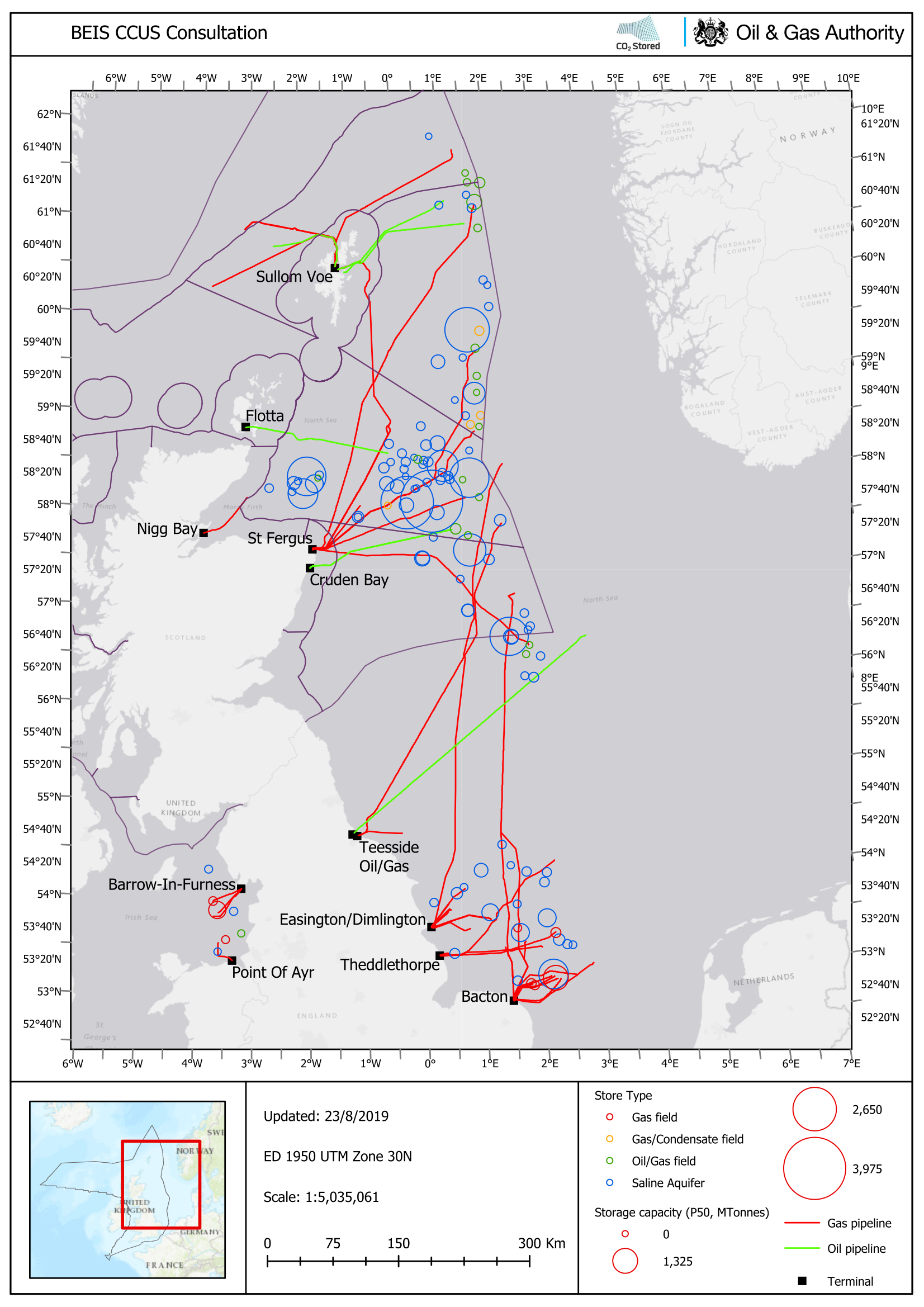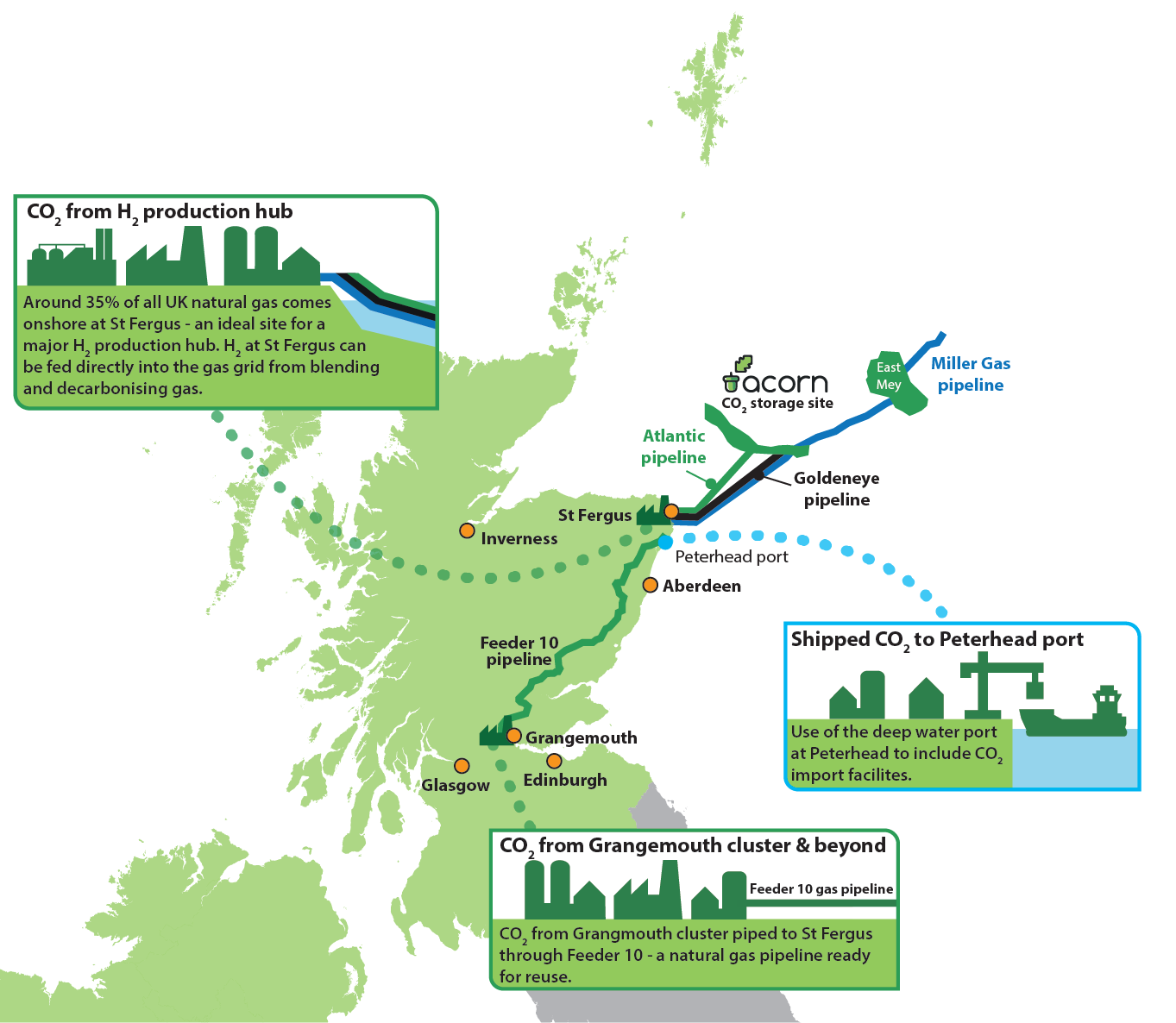Sections
Key message

What, why and where?
Carbon capture utilisation and storage (CCUS) is the capture and transport of carbon dioxide (CO2) for safe and permanent storage deep underground in a geological formation. This contributes to the mitigation of climate change. The process captures waste CO2 from large point sources, such as biomass or fossil fuel power plants, industrial processing or cement production.
Scotland has vast potential for the geological storage of carbon under the seabed of the North Sea (Scottish Government, 2009). The repurposing of key existing pipelines for CO2 transportation offers the largest cost-saving opportunity for the deployment of CCUS in the UK. Scotland’s industrial clusters and largest point sources of CO2 in the north east and Grangemouth are linked by a network of pipelines to depleted and well-mapped oil and gas fields in the North Sea.
The depleted gas fields and aquifers identified as suitable for injection of CO2 in the Central North Sea are far larger than the totality of Scotland’s carbon emissions. This Central North Sea Storage Hub could be able to receive and store as much as 500 million tonnes a year by 2050: equivalent to 25 per cent of total EU emissions (at 2007 levels) (Scottish Carbon Capture and Storage, 2012).
CCUS is crucial to the delivery of zero greenhouse gas (GHG) emissions and strategically important to the UK economy. While global progress has been slow, there are now 43 large-scale projects operating or under development around the world (Committee on Climate Change, 2019). CCUS policy is devolved to Scotland, however UK funding, licencing and regulation is reserved to the UK government.

Figure 1: Map of UK offshore infrastructure and potential carbon dioxide storage sites from Department for Business, Energy & Industrial Strategy (BEIS) 2019 consultation. Source: Carbon capture, usage and storage (CCUS) projects: re-use of oil and gas assets. UK Government (2019). Contains information provided by the Oil and Gas Authority and/or third parties. Information provided on the basis of the NDR (National Data Repository) User Agreement: © 2019 Oil & Gas Authority.
European context
The permanent storage of CO2 in the UK must comply with the requirements of the EU CCS Directive (2009/31/EC). The Directive sets out processes to ensure environmentally safe storage of CO2, through permanent containment in such a way as to prevent and, where this is not possible, eliminate as far as possible any negative effects and any risk to the environment and human health (European Commission, 2015).
Over the last two decades some 20 million tonnes of CO2 has been stored by Norwegian projects in rocks deep beneath the North Sea. These projects and many others worldwide provide evidence that CO2 storage can be safe, secure and enduring (Oxburgh, 2016).
Scottish Infrastructure
The UK Government have identified a list of current offshore oil and gas pipelines in the Scottish sector they believe to be suitable for re-use for CCUS projects. This list (Table a) includes the Goldeneye pipeline, a key part of the Acorn project (see below).
|
Asset name
|
Asset type
|
|
Goldeneye
|
Pipeline
|
|
Atlantic and Cromarty
|
Pipeline
|
|
The Miller Gas System
|
Pipeline
|
The Acorn pilot project
The Acorn project (Pale-blu.com, 2019) (Figure a) is a standalone industrial CCUS project. The aim of the project is to deliver a low-cost carbon capture utilisation and storage (CCUS) system in north east Scotland. The project builds upon existing research, such as an appraisal of potential CO2 storage sites and options to re-use oil and gas assets, to move the Acorn project from proof-of-concept towards design studies.
The project is centred on the St Fergus Gas Terminal north of Aberdeen, which is connected to a series of offshore pipelines, three of which could be redeployed. St Fergus is also connected to the UK National Gas Grid and a dedicated pipeline to the Central Belt.

Figure a: Location of main sites involved in Acorn project. Source: Pale Blue Dot Energy Ltd.
The project will consider a step-by-step approach to minimise initial investment. It will start with CO2 capture and storage from the gas terminal, and then explore options for build-out to other large-scale sources of emissions in the region and from inbound shipping tankers.
The main work will focus on re-using existing infrastructure, not only for the implementation of Acorn in the UK but also to develop policy recommendations for the preservation of important infrastructure around the wider North Sea region. The Acorn project could be operational from St Fergus by 2024.
Contribution to the economy
The development of CCUS could offer a range of opportunities for Scottish oil and gas firms and domestic supply chain companies. From building and maintaining pipeline infrastructure to offering Scotland’s extensive experience in platform and well management. Scotland already has the expertise and transferable skills to kick-start what could become a whole new on and offshore industry.
While there are no working CCUS sites in 2019, estimates suggest that by 2030 anywhere between 7,000 and 45,000 UK jobs could ultimately be associated with CCUS, with Scotland securing 40% of the carbon storage element of a European CO2 management market. By 2050 this could rise to between 22,000 and 105,000 UK jobs, and more as the industry extends to low carbon fuel supply (Scottish Enterprise, 2019).
Examples of socio-economic effects
- Helps reach climate change targets – crucial to achieving the delivery of zero greenhouse gas emissions.
- Contributes to economic growth by placing Scotland in a lead role in an emerging sector.
- Uses existing pipelines and infrastructure no longer required for oil and gas.
- CCUS deployment costly, innovation required to make cost effective.
- Released CO2 from any leakage would have an impact on the environment and could result in unforeseen costs.
Pressures on the environment
An OSPAR agreed list of marine pressures is used to help assessments of human activities in the marine environment. The marine pressure list has been adapted for use in Scotland via work on the Feature Activity Sensitivity Tool (FeAST). Carbon capture utilisation and storage activities can be associated with 19 marine pressures – please read the pressure descriptions and benchmarks for further detail.
The list of marine pressures is used to help standardise assessments of activities on the marine environment, and is adapted from an agreed list prepared by OSPAR Intercessional Correspondence Group on Cumulative Effects (ICG-C) (see OSPAR 2014-02 ‘OSPAR Joint Assessment and Monitoring Programme (JAMP) 2014-2021’ Update 2018’ (Table II).
The Feature Activity Sensitivity Tool (FeAST) uses the marine pressure list to allow users to investigate the sensitivity of Scottish marine features. It also associates all pressures that might be exerted by a defined list of activities at a particular benchmark. The extent and impact of each pressure from a given activity will vary according to its intensity or frequency. The extent and impact of the pressure will also vary depending on the sensitivity of the habitat or species on which it is acting. The existence of multiple activities, and potentially multiple pressures, at specific locations will result in a cumulative impact on the environment.
FeAST is a developing tool. A snap shot from 2019 was used for the development of SMA2020. Please consult the FeAST webpage for further information and up to date information.
The list of pressures below associated with this activity is given in alphabetical order. Clicking the pressure will give you more information on the pressure and examples of how it may be associated with the activity.
Forward look
To meet Scotland’s climate change target of net zero emissions by 2045, CCUS needs to be rolled out at scale. The Committee on Climate Change (CCC) have stated that CCUS is essential. The CCC previously recommended that the first CCUS cluster in the UK should be operational by 2026, with two clusters, capturing at least 10 million tonnes CO₂ operating by 2030. In order to meet a net-zero target it is very likely that more clusters will be needed (CCC, 2019).
The UK Government launched its CCUS Deployment Pathway: An Action Plan in 2018 (UK Government, 2018). The Action Plan sets out the next steps government and industry should take in partnership in order to achieve the government’s ambition of having the option to deploy CCUS at scale during the 2030s, subject to costs coming down sufficiently.
In Scotland, the Acorn project could be operational from St Fergus by 2024.
Economic trend assessment
There are no working CCUS sites in Scottish waters. As such there are no trends to report.
This Legend block contains the key for the status and trend assessment, the confidence assessment and the assessment regions (SMRs and OMRs or other regions used). More information on the various regions used in SMA2020 is available on the Assessment processes and methods page.
Status and trend assessment
|
Status assessment
(for Clean and safe, Healthy and biologically diverse assessments)
|
Trend assessment
(for Clean and safe, Healthy and biologically diverse and Productive assessments)
|
||
|---|---|---|---|
 |
Many concerns |
No / little change |
|
 |
Some concerns |
Increasing |
|
 |
Few or no concerns |
Decreasing |
|
 |
Few or no concerns, but some local concerns |
No trend discernible |
|
 |
Few or no concerns, but many local concerns |
All trends | |
 |
Some concerns, but many local concerns |
||
 |
Lack of evidence / robust assessment criteria |
||
| Lack of regional evidence / robust assessment criteria, but no or few concerns for some local areas | |||
 |
Lack of regional evidence / robust assessment criteria, but some concerns for some local areas | ||
| Lack of regional evidence / robust assessment criteria, but many concerns for some local areas | |||
Confidence assessment
|
Symbol |
Confidence rating |
|---|---|
|
Low |
|
|
Medium |
|
|
High |

Assessment regions

Key: S1, Forth and Tay; S2, North East; S3, Moray Firth; S4 Orkney Islands, S5, Shetland Isles; S6, North Coast; S7, West Highlands; S8, Outer Hebrides; S9, Argyll; S10, Clyde; S11, Solway; O1, Long Forties, O2, Fladen and Moray Firth Offshore; O3, East Shetland Shelf; O4, North and West Shetland Shelf; O5, Faroe-Shetland Channel; O6, North Scotland Shelf; O7, Hebrides Shelf; O8, Bailey; O9, Rockall; O10, Hatton.



